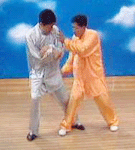
| Home | |||
| About Us | |||
| Overview | |||
| Shaolin | |||
| Hsing Yi | |||
| Tai Chi | |||
| Bagua | |||
| Baji | |||
| History | |||
| Philosophy | |||
| References | |||
| Health | |||
| Other Styles | |||
|
|
|||
| Links | |||
| Directory | |||
| News | |||
aji Quan training occur in several stages:
-
Applications
-
Two man forms
-
Weapons
Baji tries to train the student to be efficient in close quarter combat. The stance training and stepping exercises develops quick and continuous attacks. The movements are laconic using both long and short body movements that starts sharp and concise and often finish with an elbow and at the same time keeping the lower part of body stable.
Each of the forms and application builds on the following concepts:
- Beng (collapse)
- Chuo (thrust in)
- Chuankunjing (force of winding round and tie)
- Han (shake)
- Kua (hip twist) for colliding.
- Tu (break through)
- Zhou (elbowing)
- Zhuangkaojing (force of pushing and leaning)
In addition, there are also grappling, wrestling and chi kung techniques and therefore Baji is considered to be a complete style.
Stance training
aji stances are low and wide compare to Shaolin stances. Stationary training focus on four stances: horse stance (弓步,mabu), the bow and arrow stance (马步), half horse stance (半马步) and the empty stance (虚步). The horse stance is slightly wider to allow more movement in delivering a front punch. The bow and arrow stance (马步) is similar to the Shaolin stance with 60 percent of the weight on the front leg but the power issuing from the back leg during the change from horse stance to bow and arrow stance. In the half horse stance, the weight distribution (60%) is shifted to the back leg. In the empty stance, almost all the weight (90%) is distributed on the back leg.
Stance training focus initially the weight distribution but are later training will incorporate hand techniques and their potential applications. For example, from horse stance the student can practice the various palm and elbow techniques.
Stepping
取熊虎之形于神
以八极之意御气
Harnessing the Eight Extreme forces of the Earth as Energy
aji stepping can be described as moving like a bear with the spirit of the tiger. During stepping training, the practitioner learn how to shift their center of gravity quickly and effectively while covering distance and executing a technique.
Bear step ( 熊步 ) requires the student to slowly walks in a low crouch. The body weight should always be on the front leg. The spine should be straight and the up body relaxed in a natural manner. This is known as the "Bear" stance because as you move to sway your hands lightly as you move and try to capture the image of a bear. The movement can also be performed by stepping diagonally. The practitioner moves from side to side but maintains the same weight distribution and body posture as in the bear posture.
Tiger Arm ( 虎膀 ) requires the practitioner to execute a punch with both hands stretched out while lunging forward. The technique requires the power to issue from the twisting of the hip and the stretching of the shoulder rather than the arm. During practice, both arms should remain relaxed and slightly bend at all times.
Additional stepping techniques requires the student to switch between the basic stances while moving. For example, from bear stepping to bow and arrow stance while executing a punch.
Forms
n practicing the various forms, the general rule is to "keep the body straight and use spine as an axis". Each form incorporates movements that involves the shoulders, back, elbows, pelvis. All the Sets are short but rich and try to teach the students to understand the combat principles of da (hit), shuai (throw arm like wheep), na (grasp, catch) and tui (push).
In traditional training, there forms for Baji are
- Liuzhoutou ("6 ends of elbows")
- Jin Gang Ba Shi (gold-steal eight forms) is the basic routine
- Ba Ji Xiao Jia (Ba Ji Short Form) which requires one to be stable and firm in his stance while training their grappling and striking abilities.
- Dai Ba Ji(Ba Ji Long form)trains footwork to be quick and easily maneuverable. While at the same time learns about how a hard step could increase power of a move dramatically. This would allow the practitioner to learn how to draw power from the whole body into one technique. The main offensive moves used in this routine is predominantly wrestling ones.
- Baji duijie is a two-man sparring routine which explains application of some of the techniques
- Liudakai ("6 big openings" or "making 6 holes") - means ding (thrust by elbow or knee), bao (embrace), dan (carry on the pole or yoke), ti (hold, carry), kua (step over) and chan (wind round)
- Badaizhou ("8 big methods") are advanced forms that contains more specialized techniques pertaining to this style.
- Yingshouquan ("fist of answering hands", contains 48 big blocks and 64 hand methods)
- Gonggong baji ("bajiquan of steel working")
- Baji shuanggui ("2 ruts of bajiquan")
Weapon sets
- yezhan dao ("broadsword of night fighting")
- ti liu piaoyao dao ("carring the broadsword of fluttering willow")
- liuhe daqiang ("big spear of six coordinations")
- liuhe huaqiang ("blossom spear of six coordinations")
- lianhuan jian ("continuous sword")
- jiugong chunyan jian ("sword og nine palaces of pure yang")
- danzhi gou ("sole hook")
- baji jian ("sword of baji")
2-men weapon sets
- duizha daliuheqiang ("mutual thrusts by big spears of six coordinations")
- yezhan jiumen shisan daodian ("thrusts of 13 broadswords of 9 gates of night fighting").
Copyright 2003
